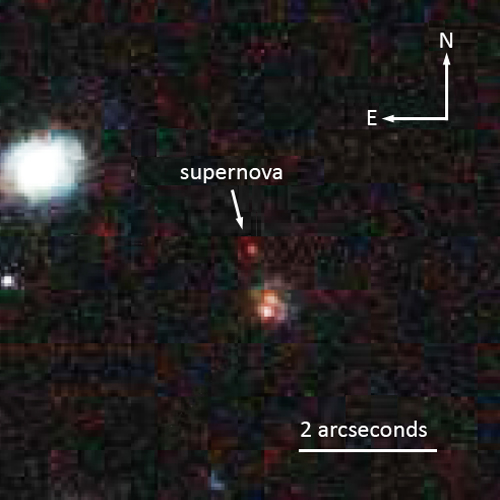
Astronomers have discovered the most distant supernova of its kind, an ancient and massive star explosion that could shed light on some of the universe's biggest mysteries.
The supernova, known as SN SCP-0401, is 10 billion light-years from Earth, meaning it exploded just 3.7 billion years after the Big Bang that created our universe. The discovery team says SN SCP-0401 is the most far-flung well-characterized Type 1a supernova, which astronomers use as "standard candles" to study the universe's accelerating expansion and the mysterious dark energy that seems to be driving it.
"This is the most distant supernova anyone has ever found for doing dependable cosmology," David Rubin, of the U.S. Department of Energy's Lawrence Berkeley National Laboratory and the University of California, Berkeley, said in a statement.
"The most important unanswered question we have about the nature of dark energy is whether it varies over time — whether it affects the expansion of the universe differently in different eras," Rubin added. "With SN SCP-0401, we have the first example of a well-measured supernova sufficiently far away to study the expansion history of the universe from almost 10 billion years ago." [The Big Bang to Now in 10 Easy Steps]
Rubin presented the results, which will also be published later this month in the Astrophysical Journal, today (Jan. 9) at the 221st meeting of the American Astronomical Society in Long Beach, Calif.
A distant needle in an enormous haystack
Rubin and his colleagues used NASA's venerable Hubble Space Telescope to make the find. SN SCP-0401 first popped onto scientists' radar back in 2004, during another Hubble survey. At the time, researchers dubbed the candidate supernova Mingus, after jazz great Charles Mingus.
Breaking space news, the latest updates on rocket launches, skywatching events and more!
Mingus was so distant and so faint — the equivalent of looking at a firefly from 3,000 miles (5,000 kilometers) away — that its true nature remained a mystery for a while, researchers said. But the 2009 installation of a new instrument on Hubble called the Wide Field Camera 3 allowed scientists to get their first good look at the object.
In the new study, researchers were able to confirm Mingus' distance and its identity as a Type 1a supernova — a "dead" white dwarf star that erupts in a titanic blast after borrowing enough material from a companion star to reach critical mass.
Type 1a supernovae all have relatively similar brightnesses, and astronomers thus use them to measure cosmic distances (the dimmer a Type 1a appears to be, the farther away it is from us).
Indeed, careful study of Type 1a supernovae allowed two teams of researchers to determine in 1998 that the universe's expansion is accelerating, driven by an odd, unseen force called dark energy. The two groups shared the 2011 Nobel Prize in Physics for the surprising discovery.
Looking back in time
SN SCP-0401 should help astronomers better understand dark energy’s possible variation over the universe's long history, researchers said. The supernova represents just one ancient data point, however, so researchers plan to look for more such distant objects.
"Hubble is our best bet to find and measure similar distant supernovae," Rubin said. "Luckily Hubble has a few good years left."
NASA officials said yesterday (Jan. 8, in fact, that they hope to keep operating Hubble through at least 2018. The telescope, a joint effort of NASA and the European Space Agency, has been observing the heavens since its launch in April 1990.
Follow SPACE.com senior writer Mike Wall on Twitter @michaeldwall or SPACE.com @Spacedotcom. We're also on Facebook and Google+.

Michael Wall is a Senior Space Writer with Space.com and joined the team in 2010. He primarily covers exoplanets, spaceflight and military space, but has been known to dabble in the space art beat. His book about the search for alien life, "Out There," was published on Nov. 13, 2018. Before becoming a science writer, Michael worked as a herpetologist and wildlife biologist. He has a Ph.D. in evolutionary biology from the University of Sydney, Australia, a bachelor's degree from the University of Arizona, and a graduate certificate in science writing from the University of California, Santa Cruz. To find out what his latest project is, you can follow Michael on Twitter.
